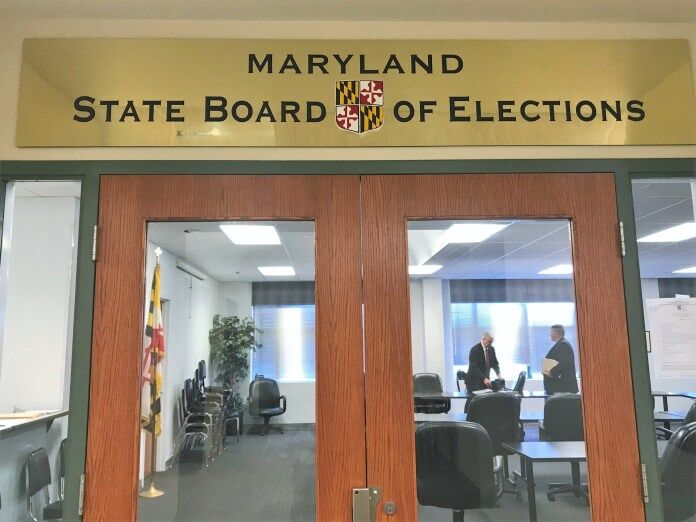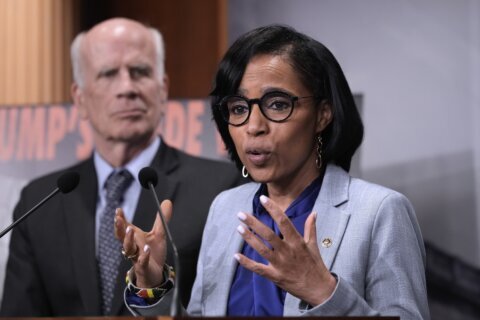This article was republished with permission from WTOP’s news partners at Maryland Matters. Sign up for Maryland Matters’ free email subscription today.

This content was republished with permission from WTOP’s news partners at Maryland Matters. Sign up for Maryland Matters’ free email subscription today.
The Maryland State Board of Elections will investigate what caused a slowdown in the pollbooks used to check in voters during the special primary election Tuesday in the 7th Congressional District.
The books were connected to a state voter database in Annapolis through a wireless network that is slated for a widespread rollout in Maryland’s largest counties for the 2020 election.
While a similar network has been used previously at the limited number of early voting centers in Maryland’s counties, the special election Tuesday marked the first widespread election day use of the network — the necessity and security of which has been questioned by state elections board members and Montgomery County officials in recent months.
On Thursday, the Senate Education, Health and Environmental Affairs Committee considered an emergency bill from Sen. Cheryl C. Kagan, D-Montgomery, that she introduced in an effort to remove the need for the wireless networks.
The state elections office plans to install the secure networks at 1,300 polling places in the state’s six largest jurisdictions ― Baltimore City and Anne Arundel, Baltimore, Howard, Montgomery and Prince George’s counties ― to transmit real-time voter registration changes from electronic pollbooks to the state office in Annapolis during voting. State elections administrative officials said the network is needed to handle a potential increase in the volume of transactions with the state’s shift to same-day voter registration.
At state board meetings, county officials have worried that the wireless networks leave the state’s election system vulnerable, because each network is a new potential access point for a bad actor at a time of increased fears of election meddling and integrity. Montgomery County has also balked at the increased cost for the expansion.
The first test of the system came Tuesday during the special election in the 7th District, which includes portions of Baltimore City and Baltimore and Howard counties.
Well into Tuesday’s election, Howard County officials reported that its pollbooks were running slowly. Around 5:30 p.m., county and state officials decided to disconnect the pollbooks from the wireless network, which improved their speed.
Until the disconnection, data from the pollbooks was properly transmitting to the database in Annapolis, Nikki B. Charlson, the state elections board’s deputy director, said Wednesday afternoon.
Disconnecting from the network sped up the pollbooks, and the elections were able to continue without issue, Howard County elections Director Guy Mickley said Wednesday.
“Whether we’re connected or not, the election is still being conducted,” Mickley said.
After the disconnection appeared to improve pollbook speeds in Howard County, the network was also disconnected in Baltimore City and Baltimore County just before 6:30 p.m., Charlson said.
The network at issue concerns voter registration and ballot data, and is entirely separate from the state’s voting system, Charlson said.
Because the volume of transactions Tuesday was much lower than a statewide general election day, counties faced no delays in manually uploading the pollbook data at the end of the night.
Before the disconnection, roughly 200 same-day voter registration changes had been transmitted over the network, Charlson said.
Mickley said the network allowed elections officials to get a real-time look at data, including turnout numbers. “Once they work out the kinks, this is going to be a super tool for us going into the future,” Mickley said.
But news that the network didn’t function as intended rankled Kagan.
“Election Day is not the time to experiment with risky new gadgets,” Kagan said.
The emergency bill she introduced in January would delay the start of the state’s first absentee canvass. Doing so would remove the urgency for data transmission and for the wireless networks that have caused so much concern, Kagan said.
Her skepticism about the networks increased substantially after Tuesday, particularly because the scale of the election included “a tiny fraction of the number of registered voters, voting in just one-eighth of our state.”
“If there were problems then, it’s shocking that anyone would believe we would expand that,” Kagan said.
Charlson on Wednesday said the state board undertakes reviews after every election day and will investigate the cause of the slowdown on Tuesday. “We are going to find the cause of the issue, find a fix, implement the fix and test it,” she said in an interview.
Charlson said it was premature to reach conclusions about causes of the problems on Wednesday or the fate of the networking system.
“If it proves itself in testing, we’re going to use it,” she said.
Charlson also said Wednesday there was no evidence of nefarious activity.
The rollout of the proposed network has caused consternation among the State Board of Elections oversight board in recent months.
In January, Montgomery County officials appeared at the state meeting asking to opt out of the network, citing concerns about cost and security.
At that meeting, some state board members also expressed concerns about the system, the rollout of which has been overseen by elections staff without formal action from the board.
Board member Kelly Howells said Wednesday she was surprised to hear about the issues related to Tuesday’s elections from Maryland Matters.
“I’m very frustrated by the lack of information being shared with the oversight board,” Howells said.
Given the concerns that have come up about the program, Howells said she wishes the board had been consulted along the way. “I would have wanted to know that every opportunity, every alternative, to wireless networking had been explored,” Howells said.
The issue is likely to arise at the election board’s next meeting later this month.
Since last fall, board members have received closed-door briefings to address questions about the system, but those questions were not addressed during open board meetings.
Charlson has stated publicly that the wireless networks are masked at polling places, and the information transferred is encrypted. Precincts also maintain backups of the pollbook information.







